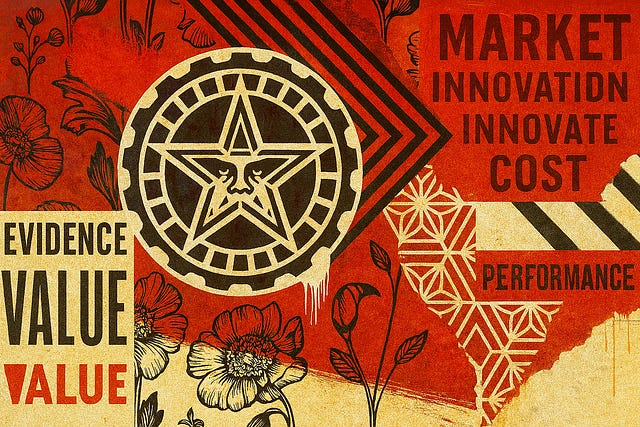PMO Turning Governance into Value 01: Your PMO Is Not a Reporting Function. It’s a Value Engine.
If your PMO is only tracking delivery dates, you don’t have a PMO. You’ve got a spreadsheet nanny.
Welcome to the first blog in my series on changing how we think about PMOs, what they’re for, how they work and why most perceptions of them are flat wrong.
I’ll be sharing insights on how PMOs can (and should imo) be run, based on what I’ve learned from setting them up in everything from global enterprises to startups.
It’s about creating value, proving it and building the kind of processes that bring clarity, not chaos.
Series Title:
Rewriting the Rules of the PMO: Turning Governance into ValueTheme:
Challenge the perception of PMOs as bureaucratic bottlenecks and reframe them as modern engines of business value, adaptive leadership and strategic clarity.Each post helps people rethink what a PMO should do, how it should behave, and what real success looks like.
If your PMO is only tracking delivery dates, you don’t have a PMO. You’ve got a spreadsheet nanny.
I’ve seen it too many times:
A PMO set up to “keep track” of projects, hoover up RAG statuses and make sure people fill in their reports on time.
It looks like control. It feels like governance.
But it delivers… nothing.
The truth is, a PMO is only valuable when it helps the business realise value…when it makes sure the right things get worked on, by the right people, at the right time, for the right reasons.
This isn’t project admin with a fancier title.
It’s about impact.
…nd that starts by flipping the script on what a PMO is really for.
Follow me on medium: https://medium.com/@jdotharrison
The PMO’s Real Job: Make Value Happen
The PMO exists for one purpose:
To make sure the business invests in the right things…and sees a return on that investment.
That means:
Connecting projects and products directly to business goals
Ensuring clear OKRs and a product vision before work even begins
Tracking not just delivery, but actual value realisation
Acting as a translator between leadership, delivery teams and business units
When this clicks, everything else…governance, stakeholder management, reporting…gets signifciantly easier.
It’s the difference between:
“Why are we doing this project again?”
and
“Here’s the outcome we’re delivering, and how we know we’re on track.”
Where Most PMOs Go Wrong: The Reporting Trap
We’ve all seen it:
Endless dashboards nobody trusts
PMs chained to RAG statuses
Slide decks updated more often than risk logs
This isn’t governance.
This is theatre.
PMOs fall into the trap of reporting on projects instead of managing them to outcomes.
They get obsessed with templates, colour codes, and tick-boxes…forgetting to ask:
Does this project make sense for the business?
Will it deliver meaningful value?
Have we even defined what success looks like?
Reframing the PMO: From Admin to Advisor
So how do you flip it?
Stop acting like a report generator.
Start acting like a business advisor.
That means:
Embedding in the strategy, not just delivery
Asking the hard questions upfront…“What problem are we solving?”
Saying “No” when work doesn’t align (or at least “Not yet”)
Building governance that gives clarity…not bureaucracy
Good PMOs don’t force compliance. They foster confidence.
Value Is Measured After Delivery, Not Before
One of the biggest myths?
That a project is successful because it finished on time and on budget.
Here’s reality:
A project only succeeds when it delivers its intended business results.
Hitting a deadline is great.
But if the outcome misses, you’ve wasted time and money.
That’s why value assessment must be baked into your workflow from phase 0 to post-launch.
Delivery is halfway.
The PMO’s job is to make sure the finish line actually matters.
Follow me on medium: https://medium.com/@jdotharrison
Common Myths About PMOs (and Why They Hurt You)
❌ “The PMO Is the Process Police”
If you act like compliance cops, you lose trust.
Good PMOs enable delivery. They don’t enforce it.
❌ “We’re Here to Report, Not Challenge”
If all you do is report health status, you’re not helping.
Your role is to challenge decisions that don’t fit strategy…and protect delivery teams from bad work.
❌ “We’ll Build Credibility After We Roll Out the Framework”
Nope.
You earn credibility first…then you earn the right to build the framework.
Solve problems first. Build later.
Measuring Value through Flow & Status Monitoring EVM & EBM
In last weeks blog I spoke heavily about EBM metrics and how they can help measure the value outcome of your business.
They’re great, but for a PMO, not stand alone.
A PMO needs to have eyes on EVM metrics too. It’s all good knowing you innovate fast, but if you don’t have a handle on your costs and risks, you’re not doing your job.
You need both.
Valuable Clarity. (might coin that phrase, possible TM?)
📊 EVM: Your Clarity Dashboard
Earned Value Management (EVM) tracks whether a project is on time, on budget, and delivering work as planned.
I use it to:
Show planned vs actual progress
Spot cost and schedule variances early
Give PMs the data they need for a clear picture of the programme or portfolio
EVM Core Metrics:
Planned Value (PV) — Budgeted cost of scheduled work
Earned Value (EV) — Budgeted cost of completed work
Actual Cost (AC) — Actual cost incurred
Performance Indicators:
Cost Variance (CV) = EV — AC
Schedule Variance (SV) = EV — PV
Cost Performance Index (CPI) = EV / AC
Schedule Performance Index (SPI) = EV / PV
EVM Example
Planned Value (PV) = $100,000
Earned Value (EV) = $80,000
Actual Cost (AC) = $90,000
Cost Variance (CV) = EV — AC = -$10,000 (We’ve overspent)
Schedule Variance (SV) = EV — PV = -$20,000 (We’re behind schedule)
CPI = EV / AC = 0.89 (Poor cost efficiency)
SPI = EV / PV = 0.80 (We’re delivering only 80% of what we planned)
The story?
We’re behind and over budget…time for decisions before this gets worse.
🧩 EBM: Your Business Value Compass
EVM keeps you in control.
EBM keeps you focused on value.
Evidence-Based Management (EBM) tracks business impact using four lenses:
Current Value (CV) — What value are we delivering right now?
Unrealised Value (UV) — What future opportunities could we unlock?
Ability to Innovate (A2I) — How fast can we adapt and deliver new things?
Time to Market (T2M) — How quickly do we deliver new value?
I’ve used EBM to:
Show execs how projects connect to business goals
Highlight gaps between spend and actual benefit
Prove the PMO is driving better decisions…not just tracking status
EBM Example
Imagine a product launch:
We delivered on time, but customer adoption is low
Current Value = Low revenue generation
Unrealised Value = Market potential remains untapped
Ability to Innovate = Low, because feedback loops aren’t in place
Time to Market = Good, we launched quickly
The insight?
We delivered fast, but without enough market fit testing…so future value is at risk.
We need better innovation cycles, not just faster delivery.
EBM exposes what delivery alone can’t show.
Follow me on medium: https://medium.com/@jdotharrison
Why This Matters
C-suites don’t care how many projects you’re running.
They care whether those projects are driving business performance.
EVM tells them things are under control through clarity.
EBM tells them you have eyss on creating value.
When you use both, your PMO moves from traffic cop to strategic advisor.
How I’ve Seen This Work (and Not Work)
At Pandora and Getinge, I set up PMOs without anyone even noticing.
Because it wasn’t about control. It was about clarity and value.
We built governance that made sense.
We trained teams to think outcomes first.
We built consistent ways of working…without killing flexibility.
The result?
Silos broke down
Politics cooled off
Projects connected better to business goals
People actually wanted to engage with the PMO
When it didn’t work, the reason was always the same:
The PMO got obsessed with tracking, not helping.
Conclusion
If you want a PMO that makes a real difference:
Stop seeing it as a governance body.
Start running it as a business value partner.
🔥 5 Key Takeaways
The PMO’s real role is to realise value, not just report status
Governance should empower delivery teams, not control them
Projects succeed when they deliver business outcomes, not when they hit milestones
EVM keeps you in control, EBM keeps you valuable
PMOs that connect delivery to strategy earn lasting credibility
If your PMO still acts like the spreadsheet police, it’s time for a rethink.
You’re not alone.
Follow me on medium: https://medium.com/@jdotharrison






I love it. And I'd love to share it with my PMO, but I'm afraid they wouldn't take it very well, haha